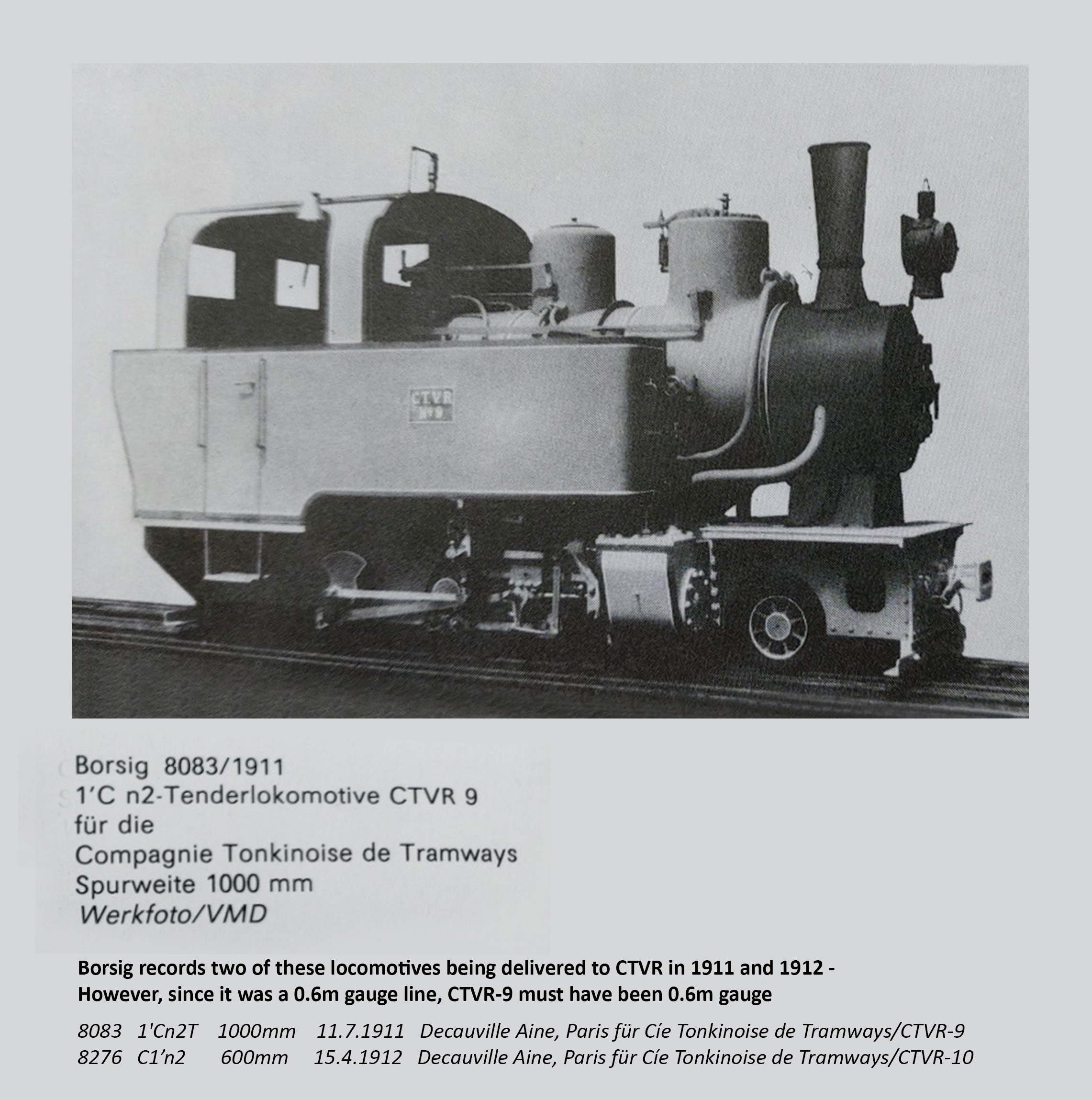
Borsig 2-6-0T (130T) locomotive, one of two such locos acquired in 1911-1912 by the Compagnie Tonkinoise de tramways à vapeur sur routes (Phủ Ninh Giang-Cẩm Giàng tramway)
One of French Indochina’s numerous short-lived steam tramways, the 42km line from Phủ Ninh Giang to Cẩm Giàng in the Red River Delta operated for just 12 years before it was decommissioned.
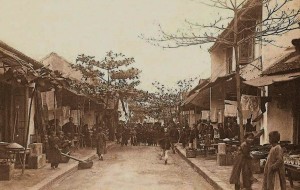
Phủ Ninh Giang Market
In early 1899, a Hà Nội-based French entrepreneur named Balliste submitted a request to the Tonkin authorities to establish a 35km, 0.6m-gauge steam tramway linking Phủ Ninh Giang (now Ninh Giang) with Kẻ Sặt in Hải Dương Province, the primary aim being to transport rice and tobacco from one of the north’s most fertile agricultural areas to the processing mills at Phủ Ninh Giang.
The project was subsequently taken over by Đáp Cầu–based businessman Eugène Le Roy, who was authorised by a convention of 7 July 1899 and subsequent decision of 10 August 1899 to proceed with the construction and exploitation of the line. On 18 November 1900, the concession was retroceded to Le Roy’s Compagnie Tonkinoise de tramways à vapeur sur routes (Tonkinese Steam Tramway Company, CTTVR).
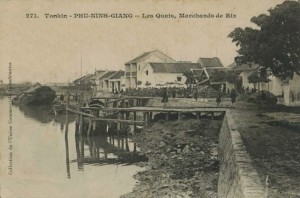
The quai du Canal des Bamboos at Phủ Ninh Giang
As the company’s name suggests, it was expressly agreed that in order to save money the tramway line should be built along existing public roads. Construction got under way in October 1900 and continued for more than two years.
Unwilling to grant the company a direct subsidy, the Tonkin authorities undertook instead to supply it free of charge with redundant rolling stock, track, signalling and other equipment from the original 0.6m-gauge Phủ Lạng Thương-Lạng Sơn railway line. A convention of 3 April 1903 promised the CTTVR four 9.5-ton Decauville 0-4-4-0 “Mallet” patent compound jointed locomotives – No 85 “Commandant-Riviere,” No 86 “Carnot,” No 126 “Comte-de-Lagrée” and No 188 “Kinh-Luoc” – plus three tenders, two mixed first-class and second-class carriages, three third-class carriages, four fourth-class carriages, eight flat bogie wagons, 44 gondola wagons, three bogie parcels wagons and one parcels van.
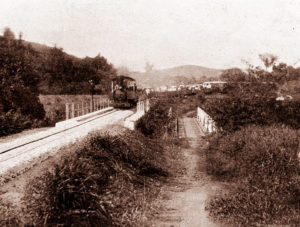
“Tonkin, November 1898 – Train longeant l’ancienne route de Langson,” depicting one of the 0.6m gauge Decauville 0-4-4-0 “Mallet” compound jointed locomotives on the original Phủ Lạng Thương-Lạng Sơn line a few years before it was sent to the Compagnie Tonkinoise de tramways à vapeur sur routes
Work got under way in October 1900 and continued for more than two years. However, by this time, construction of the Hải Phòng-Hà Nội section of the Yunnan Railway by the Compagnie française des chemins de fer de l’Indochine et du Yunnan (CIY) was also in progress. In 1902, as the tramway project neared completion, the CTTVR was authorised to extend its line a further 7km from Kẻ Sặt to connect with the CIY main line at Cẩm Giàng junction.
Unfortunately, due to unrest in the far north, delivery of the second-hand equipment promised by the government was delayed, and when it did arrive, most of it turned out to be in such a state of disrepair that it was unusable. Furthermore, the majority of the second-hand rails were supplied in curved sections, with insufficient straight sections for the new tramway’s alignment. For this reason, the company was obliged to incur significant additional expense purchasing new track and restoring the second hand rolling stock to operational condition.
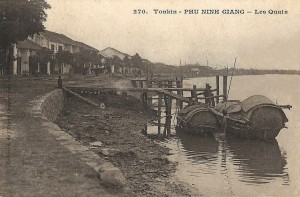
Another view of the quai du Canal des Bamboos at Phủ Ninh Giang
As the project neared completion in 1902, the CTTVR was authorised to extend the line a further 7km from Kẻ Sặt to connect with the CIY main line at Cẩm Giàng.
After the “soft opening” of an initial 19km on 1 November 1902, the 35km Phủ Ninh Giang–Kẻ Sặt section opened to traffic on 3 May 1903, and the final 7km extension from Kẻ Sặt to Cẩm Giàng junction was put into operation on 25 January 1905. The total cost of construction was more than 860,000 francs.
Decauville records show that in 1905, CTTVR acquired two additional 9.5-tonne Decauville 0-4-0+0-4-0 (020+020) “Mallets,” numbered 9 and 10.
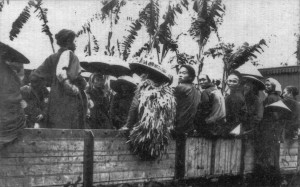
Open wagons from the Phủ Lạng Thương–Lạng Sơn railway line were used on the tramway
When it first opened, the 43km Tramway de Phu-Ninh-Giang à Késat et Camgiang had relatively few stops, but by 1910 there were 26 — Quai du Canal des Bamboos (Luộc River, km 0), Phủ Ninh Giang (km 0.446), Chợ Vẽ (km 3.326), Phố Chuối (km 4.320), Bói Giàng (km 6.172), Làng Bao (km 8.346), Phụng Xá/Bình Hoàng (km 9.972), Tệ Cầu (km 11.8), An Cư (km 12.972), Họ Bóng (km 17.488), Chợ Bóng (km 17.326), Cầu Duệ (km 18.722), Thanh Viên (km 21.297), Phạm Lâm (km 23.355), Binh Đê La Xá (km 25.149), Làng Nòn (km 26.450), Lồi Dượng (km 28.197), Bình Giang (km 29.460), Mý Trạch (km 30.408), Ba Đông (km 31.713), Tráng Liệt (km 35.379), Kẻ Sặt (km 35.844), Thi Văn (km 37.620), Đông Giao (km 38.860), Cẩm Giàng (km 42.802) and what was known as the “Buttoir terminus” in Cẩm Giàng (interchange with CIY trains, km 42.900). In order to save money, 32.5km (75 percent) of the tramway line was built alongside existing public roads.
According to the CTTVR, between 1906 and 1911 the tramway moved more than 300,000 passengers and 20,000 tons of merchandise, but revenue always fell short of expectations, largely because many local traders continued to ship their rice by river. As a result, the company ran at an annual loss, with occasional natural disasters such as broken dykes only adding to its woes.
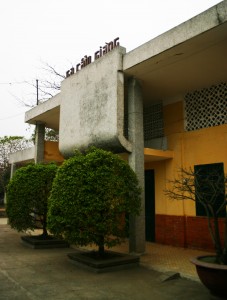
Cẩm Giàng station pictured in 2011
As early as 1908, the company requested the government either to buy back the franchise or to provide it with an annual grant plus additional funds for the purchase of two additional locomotives. The government opted for the latter, and in 1909 the company was offered an annual subvention of 50,000 francs plus a one-off grant of 50,000 francs to purchase new motive power.
Two Borsig 2-6-0T (130T) locomotives arrived in 1911 and 1912 (see large photo above) – again confusingly numbered 9 and 10!
Despite this injection of funds, the company’s financial problems persisted. In the Spring of 1910, the Governor General agreed in principle to buy back the franchise, but in the years that followed, the annual subvention continued to be paid and no action was taken to wind up the concession.
After 1912, the condition of track and rolling stock went into sharp decline due to lack of maintenance, and services on the line became increasingly sporadic. In September 1913, the authorities offered the CTTVR a 12,000-piastre grant to carry out essential repairs and maintenance, but this proved insufficient to keep the company afloat. Despite the best efforts of the Hải Phòng Chamber of Commerce to save it, the tramway ceased operations on 31 October 1914.
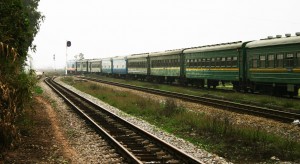
A Hải Phòng-bound train waits to depart from Cẩm Giàng in 2011
Following its closure, the Indochina authorities briefly studied the possibility of upgrading the tramway into a 1m-gauge railway line and offering it as a concession to the CIY, operator of the Yunnan Railway, with which it was already linked at Cẩm Giàng Junction. As an interim measure while this plan was under consideration, an agreement was reached with the CTTVR whereby the Department of Public Works kept the entire tramway in “cold storage” on behalf of the company, leaving the track in place and building additional depot facilities to protect the rolling stock from the elements.
The tramway finally passed into government ownership on 19 January 1922, but by that time the plan to upgrade the tramway line had been abandoned, and later the same year the track and rolling stock were removed. On 30 October 1925, 11 years after it had closed to traffic, the Tramway de Phu-Ninh-Giang à Késat et Camgiang was formally decommissioned.
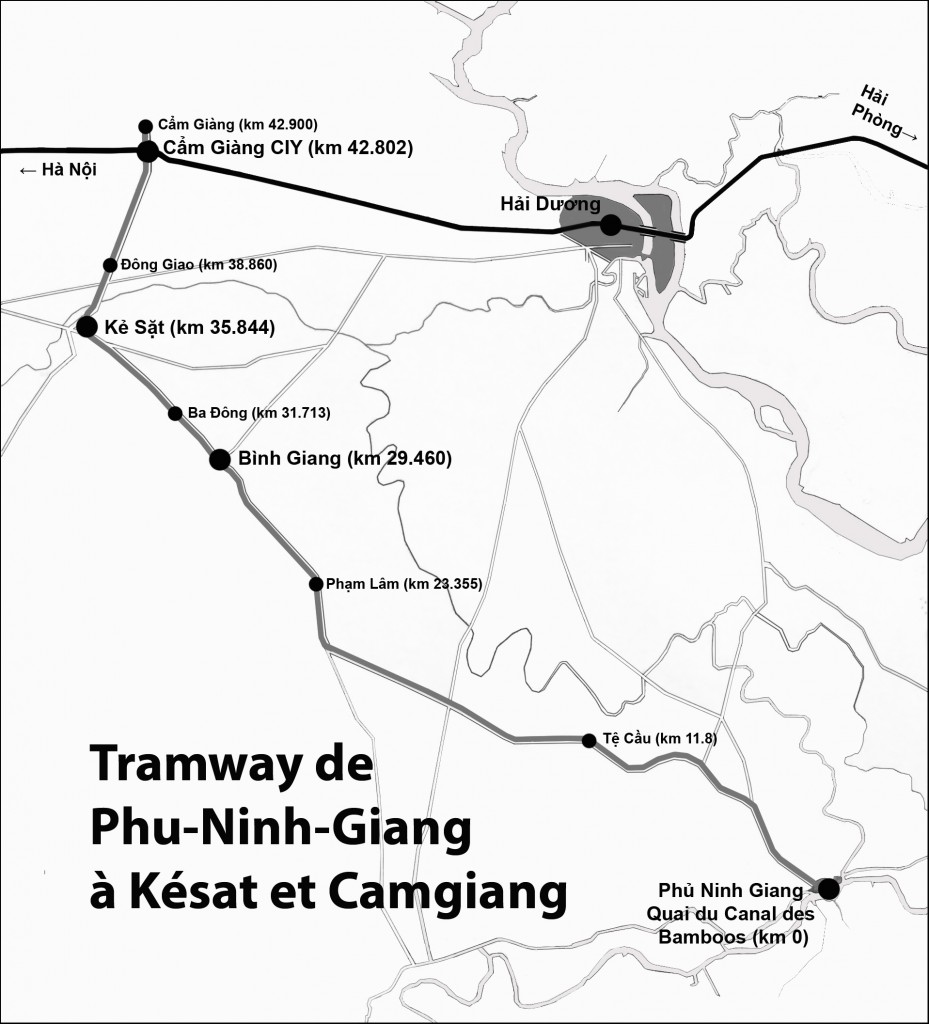
The Tramway de Phu-Ninh-Giang à Késat et Camgiang
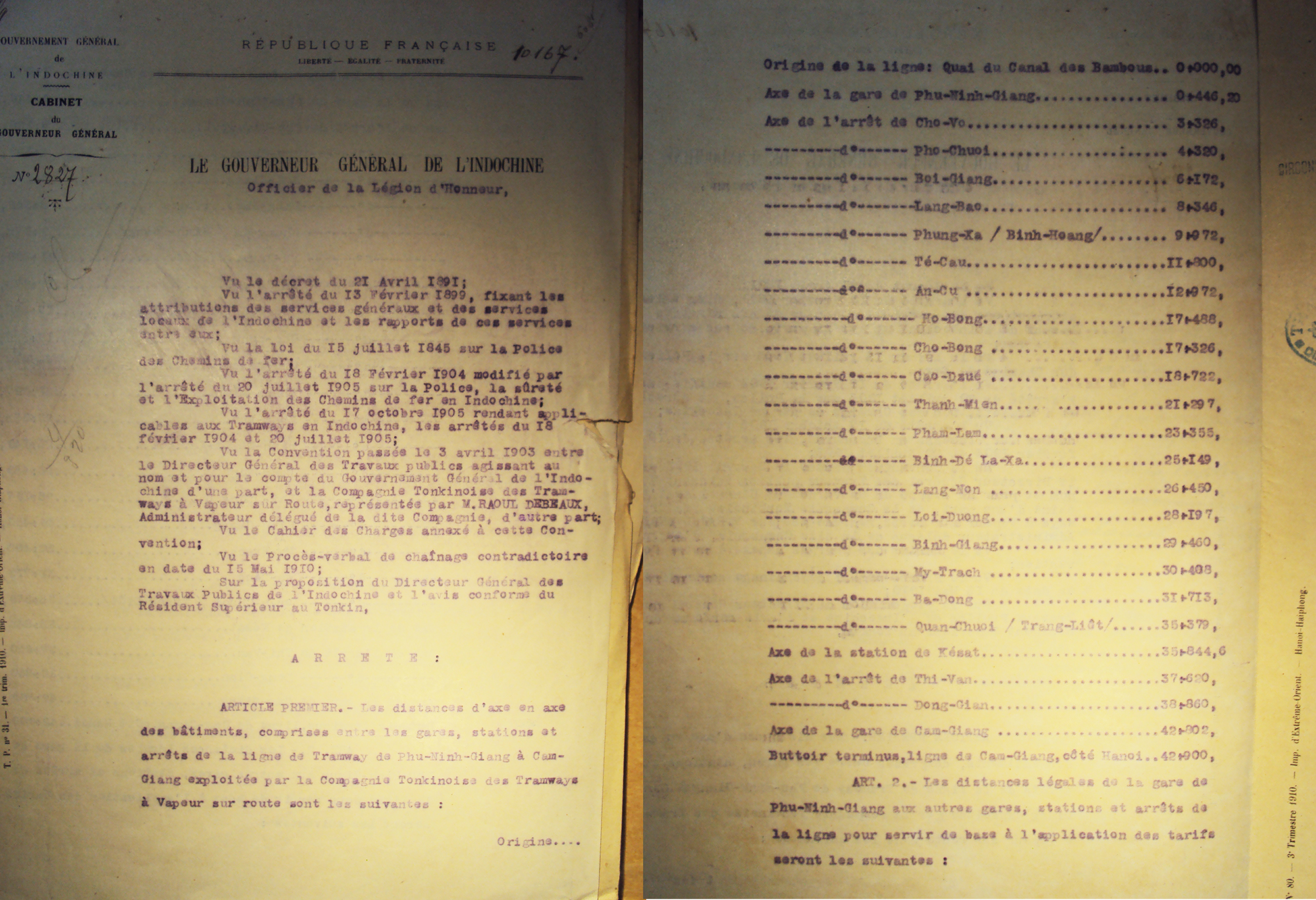
Arrêté du 7 September 1910: La ligne de Tramway de Phu-Ninh-Giang à Cam-giang exploitée par la Compagnie Tonkinoise des Tramways a vapeur sur routes – list of stations (Document Indochine GGI Indo //17865 CAOM)
Tim Doling is the author of The Railways and Tramways of Việt Nam (White Lotus Press, Bangkok, 2012) and also gives talks on Việt Nam railway history to visiting groups.
A full index of all Tim’s blog articles since November 2013 is now available here.
Join the Facebook group Rail Thing – Railways and Tramways of Việt Nam for more information about Việt Nam’s railway and tramway history and all the latest news from Vietnam Railways.
You may also be interested in these articles on the railways and tramways of Việt Nam, Cambodia and Laos:
A Relic of the Steam Railway Age in Da Nang
By Tram to Hoi An
Date with the Wrecking Ball – Vietnam Railways Building
Derailing Saigon’s 1966 Monorail Dream
Dong Nai Forestry Tramway
Full Steam Ahead on Cambodia’s Toll Royal Railway
Goodbye to Steam at Thai Nguyen Steel Works
Ha Noi Tramway Network
How Vietnam’s Railways Looked in 1927
Indochina Railways in 1928
“It Seems that One Network is being Stripped to Re-equip Another” – The Controversial CFI Locomotive Exchange of 1935-1936
Saigon Tramway Network
Saigon’s Rubber Line
The Changing Faces of Sai Gon Railway Station, 1885-1983
The Langbian Cog Railway
The Long Bien Bridge – “A Misshapen but Essential Component of Ha Noi’s Heritage”
The Lost Railway Works of Truong Thi
The Mysterious Khon Island Portage Railway
The Railway which Became an Aerial Tramway
The Saigon-My Tho Railway Line

